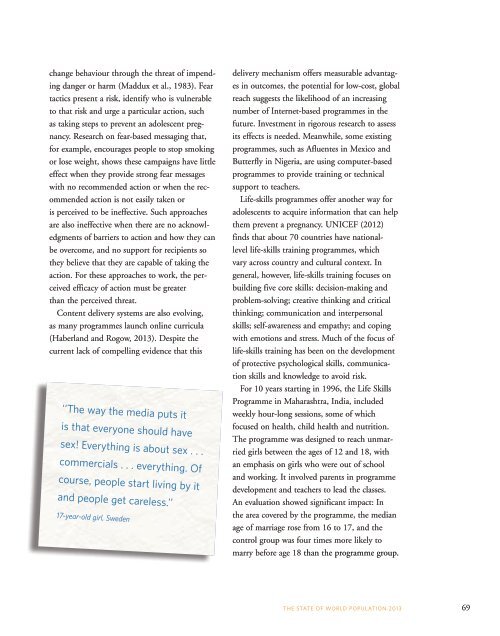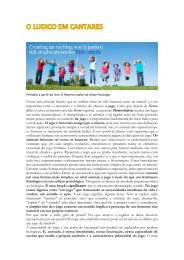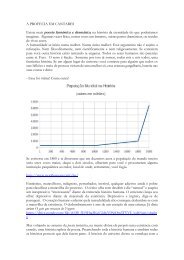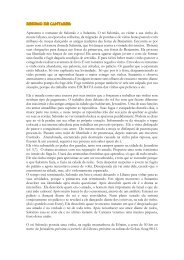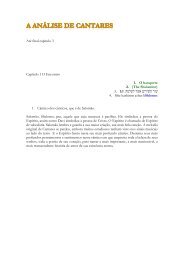Motherhood in Childhood
Create successful ePaper yourself
Turn your PDF publications into a flip-book with our unique Google optimized e-Paper software.
change behaviour through the threat of impend<strong>in</strong>g<br />
danger or harm (Maddux et al., 1983). Fear<br />
tactics present a risk, identify who is vulnerable<br />
to that risk and urge a particular action, such<br />
as tak<strong>in</strong>g steps to prevent an adolescent pregnancy.<br />
Research on fear-based messag<strong>in</strong>g that,<br />
for example, encourages people to stop smok<strong>in</strong>g<br />
or lose weight, shows these campaigns have little<br />
effect when they provide strong fear messages<br />
with no recommended action or when the recommended<br />
action is not easily taken or<br />
is perceived to be <strong>in</strong>effective. Such approaches<br />
are also <strong>in</strong>effective when there are no acknowledgments<br />
of barriers to action and how they can<br />
be overcome, and no support for recipients so<br />
they believe that they are capable of tak<strong>in</strong>g the<br />
action. For these approaches to work, the perceived<br />
efficacy of action must be greater<br />
than the perceived threat.<br />
Content delivery systems are also evolv<strong>in</strong>g,<br />
as many programmes launch onl<strong>in</strong>e curricula<br />
(Haberland and Rogow, 2013). Despite the<br />
current lack of compell<strong>in</strong>g evidence that this<br />
‘‘The way the media puts it<br />
is that everyone should have<br />
sex! Everyth<strong>in</strong>g is about sex . . .<br />
commercials . . . everyth<strong>in</strong>g. Of<br />
course, people start liv<strong>in</strong>g by it<br />
and people get careless.’’<br />
17-year-old girl, Sweden<br />
delivery mechanism offers measurable advantages<br />
<strong>in</strong> outcomes, the potential for low-cost, global<br />
reach suggests the likelihood of an <strong>in</strong>creas<strong>in</strong>g<br />
number of Internet-based programmes <strong>in</strong> the<br />
future. Investment <strong>in</strong> rigorous research to assess<br />
its effects is needed. Meanwhile, some exist<strong>in</strong>g<br />
programmes, such as Afluentes <strong>in</strong> Mexico and<br />
Butterfly <strong>in</strong> Nigeria, are us<strong>in</strong>g computer-based<br />
programmes to provide tra<strong>in</strong><strong>in</strong>g or technical<br />
support to teachers.<br />
Life-skills programmes offer another way for<br />
adolescents to acquire <strong>in</strong>formation that can help<br />
them prevent a pregnancy. UNICEF (2012)<br />
f<strong>in</strong>ds that about 70 countries have nationallevel<br />
life-skills tra<strong>in</strong><strong>in</strong>g programmes, which<br />
vary across country and cultural context. In<br />
general, however, life-skills tra<strong>in</strong><strong>in</strong>g focuses on<br />
build<strong>in</strong>g five core skills: decision-mak<strong>in</strong>g and<br />
problem-solv<strong>in</strong>g; creative th<strong>in</strong>k<strong>in</strong>g and critical<br />
th<strong>in</strong>k<strong>in</strong>g; communication and <strong>in</strong>terpersonal<br />
skills; self-awareness and empathy; and cop<strong>in</strong>g<br />
with emotions and stress. Much of the focus of<br />
life-skills tra<strong>in</strong><strong>in</strong>g has been on the development<br />
of protective psychological skills, communication<br />
skills and knowledge to avoid risk.<br />
For 10 years start<strong>in</strong>g <strong>in</strong> 1996, the Life Skills<br />
Programme <strong>in</strong> Maharashtra, India, <strong>in</strong>cluded<br />
weekly hour-long sessions, some of which<br />
focused on health, child health and nutrition.<br />
The programme was designed to reach unmarried<br />
girls between the ages of 12 and 18, with<br />
an emphasis on girls who were out of school<br />
and work<strong>in</strong>g. It <strong>in</strong>volved parents <strong>in</strong> programme<br />
development and teachers to lead the classes.<br />
An evaluation showed significant impact: In<br />
the area covered by the programme, the median<br />
age of marriage rose from 16 to 17, and the<br />
control group was four times more likely to<br />
marry before age 18 than the programme group.<br />
THE STATE OF WORLD POPULATION 2013<br />
69


